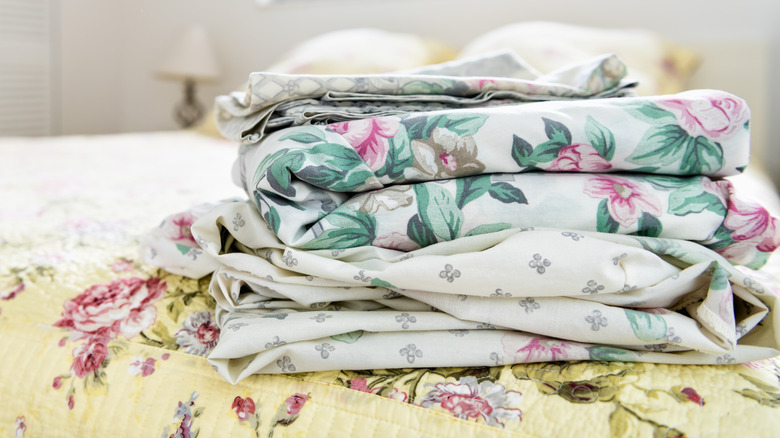Transform A Vintage Sheet Into The Perfect 'Wallpaper' For Your Accent Wall
Adding interest to a large blank wall can be one of the best ways to transform a room. Not only can accent walls add texture, pattern, and richness to even the most boring space, but they can also be used to highlight and define areas into zones. The right accent wall can also help visually heighten or lengthen a room. While adding wallpaper is one of the most popular ways to deck out a space with an accent wall, a TikTok DIYer shows off an excellent budget-friendly alternative to luxurious fabric wallpaper involving a single flat sheet and simple finishing nails to attach it to the wall.
This fun way to get a textured look with fabric wallpaper can be much less expensive and labor-intensive than installing any material that adheres to the wall. In addition, this can be a great way to reuse a unique vintage or older sheet you still love that is in great condition and matches other décor. This technique is also a more renter-friendly alternative to traditional wallpaper that can be easily removed when you move out. Patterns for bedding are often more varied than those for traditional wall coverings, making it even more possible to get the wallpaper of your dreams.
How to turn a flat sheet into a wall covering
To create this fabric-textured accent wall, make sure you have an ironed flat sheet free of wrinkles or creases, as they will be harder to get out once it is hanging on the wall. Start at the top of your wall, using small finishing nails to attach the fabric at the very top where it meets the ceiling. Add a nail every 6-10 inches, stretching the sheet as tightly as possible. Repeat the process on the bottom, attaching the nails above the baseboard and folding under any extra fabric and nailing it in place. Using smaller nails and not cutting the sheet means you could always use it as a sheet again later and/or remove it without leaving any large holes in the wall. A king size sheet is usually tall enough to cover a standard height wall, but you could also use smaller sheets for smaller areas of wall, like an alcove or above wainscoting.
If the edges of the fabric are visible, you can add some trim or molding around the sides, which not only covers up any gaps and looks more finished, but also can help stretch the fabric more tautly horizontally. If your sheet begins to sag on the wall, just pull out the nails, stretch, and reattach. For a more permanent installation you could also use a strippable wallpaper glue or liquid starch as adhesives to make the sheet attach more stiffly against the surface.
